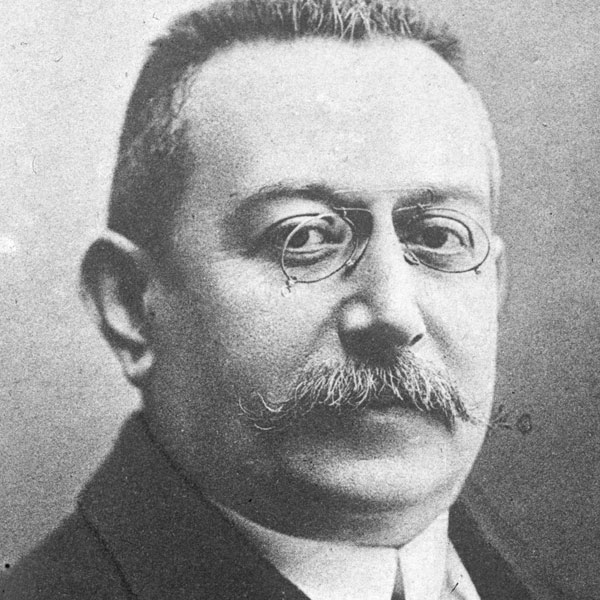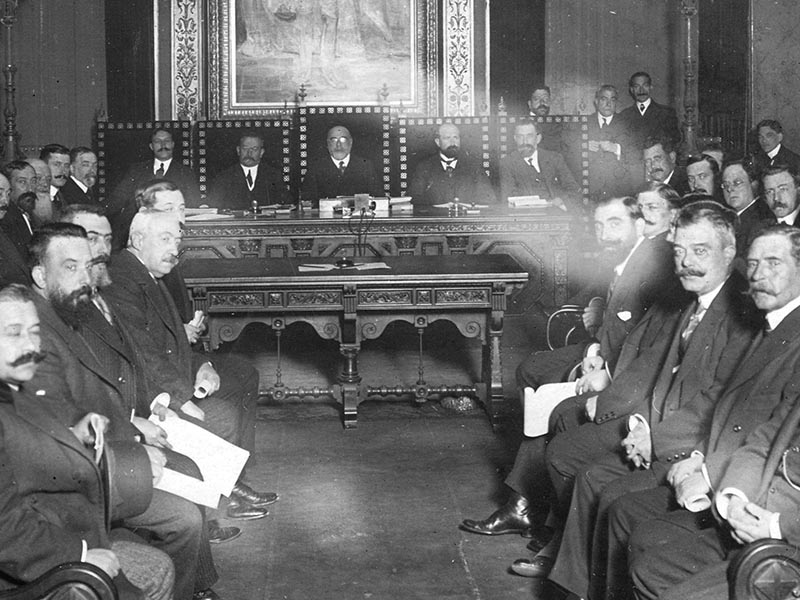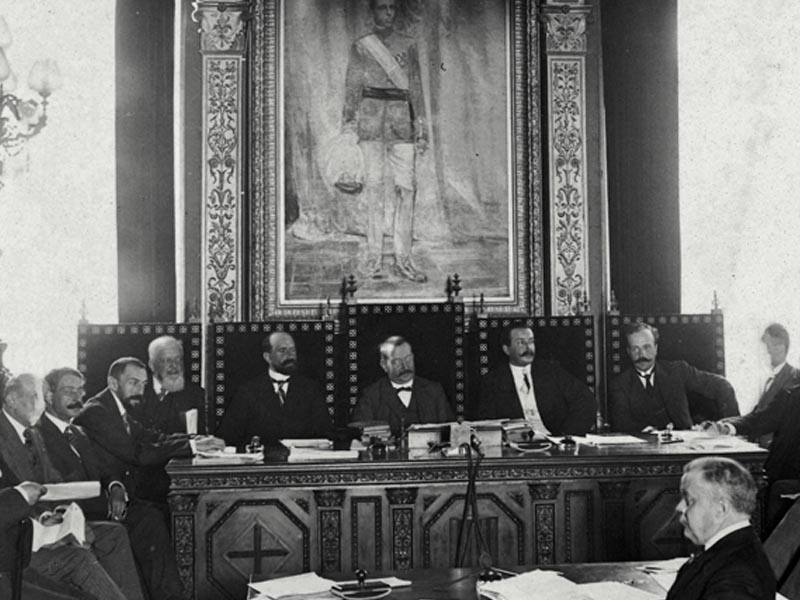Enric Prat de la Riba

Name:
Enric Prat de la Riba i Sarrà
Role:
President Commonwealth of Catalunya, Barcel0na City Council, Catalan Center
Born:
1870, Castellterçol, Catalonia
Died:
1917, Castellterçol, Catalonia
Affiliation:
Bourgeois Catalanism
Josep Maria Figueres discusses the importance of Enric Prat de la Riba to Catalonia and Catalan identity. [Enric] Prat de la Riba was a lawyer, politician, a landed journalist. Born in Castelltersol, he dies in Castelltersol, on the same bed. So this is a traditionalist committed to continuity. Prat de la Riba discovers a Catalonia through the legacy of Valentí Almirall, whom he calls the “Messiah,” and with whom he self-identifies. He works to build powerful tools. A newspaper, Voice of Catalunya, the manifesto, The Catalan Nationality. He creates a political party, the League of Catalunya, which becomes the Catalan League during the 2nd Republic. He publishes three volumes of articles and reflections. Edited by that Institute of Catalan Studies, each is nearly 1,000 pages. That’s 3,000 pages of thoughts. He is, therefore, a politician, a theorist, a man of action. Attracted to this personality trait, a group quickly elevates him to the role of secretary in multiple organizations. For example, the Catalist Center School. And he served as president of Barcelona’s provincial council. He will go on to spearhead a political union of the four… through a complex administrative process… …a union of the four Catalan provincial councils. Catalunya was split into four provinces. Each had its own civil governor, etc. Catalonia, at the time, was only considered a single administrative entity by the military. Each province communicated directly with which held all resources and rights, a centralized congress. Prat de la Riba fights for the union of the four provinces. That doesn’t mean they were separate, but that they had been split into separate political divisions by the Spanish State since the separation of provinces, similar to France’s structure. In that regard, the provinces are dissimilar to states in the U.S., which have their own political authority, congress, laws, etc. The province was a part of the whole, which was Spain. Catalunya did not exist. The League of Catalunya, the Voice of Catalonia, and Prat de La Riba work in concert to put together all the pieces required to establish a commonwealth among the four provinces. This is achieved. And with the aid of a loan, leveraging of the council budgets, and a few small transfers, the country is totally transformed. Prat de la Riba develops the image of the commonwealth, tied to the building of new roads that will signal the modernization of every Catalan town. This was the ideal. That every town must have phones and be part of a telephone network, network that, ten years later,the dictator Primo de Rivera, will appropriate after dissolving the commonwealth. The commonwealth exists from 1914 to 1924, active for only 10 years. Prat de La Riba, as the face of the Commonwealth is elected to numerous provincial postings. So, in that context, he is able to oversee numerous ventures. Roadways, telephones, libraries, and even initiatives in the farmland. Protecting birds, since they eat insects. so, in that way, active in agricultural interests. There was the development of research tools. Methodology. Competitions. Exhibitions to improve bovine breeding, etc. That’s the extent to which their government action, lacking resources, could affect the economy. He also encourages the inclusion of women. Outside of factory labor. Schools for library science, administrative training in typing, etc., a major concern at that time. So, with the connection to intellectuals, the involvement of political parties throughout Catalonia, ,and the will of the population, demonstrated through council elections, the commonwealth creates a very positive atmosphere. This endures until General Primo de Rivera’s military coup in September 1923, which is when the mancomunitat was dissolved.
Ramon Alberch discusses the importance of Prat de la Riba’s Regionalist League. The Regionalist League was a political party that brought the Catalan middle class together. The Unió Regionalista and the Centre Nacional Català converge. It is against the backdrop of the regenerationist movement, and in 1901 the ‘Lliga’ is founded. The Lliga will be the standard bearer of the Catalan right-wing through the first third of the 20th century, standing in opposition to the other great party, The Radical Republican Party. The Lliga is the party of the men of government. With Prat de la Riba, editor of 1906’s The Catalan Nationality, and the great… …thinker behind Catalunya’s reconstruction. The builder of the union of provincial councils that becomes the Mancomunitat, the Commonwealth of Catalunya. But the Regionalist League is, again, a party of governing men. Prat de la Riba is a member. Another is Puig I Cadalfach, an extraordinary architect. We have an extensive archive on him in the Catalan national archive, which includes some of his projects on Passeig de Gràcia. Some think these were the works of Gaudí, but a lot are Puig I Cadalfach, or Domenech I Montaner, another great architect. But he’s also a politician. Puig I Cadalfach will be Prat de la Riba’s successor. Then, the Lliga’s third great personality will be Francesc Cambó, a politician who reaches beyond the province of Catalunya to exert influence on the Spanish state. At its core, it’s a party of order, of bourgeiose, moderate Catalanism. Dynamic. But at that moment, very novel. It [represents] the civilized right-wing. European, with democratic ideas of freedom. It’s a huge shift from what came before, and that’s one of the great contributions of the Lliga.

1911 – Prat de La Riba and representatives of the four Provincial Councils of Catalonia gathered to form the Commonwealth, or Mancomunitat of Catalunya.
